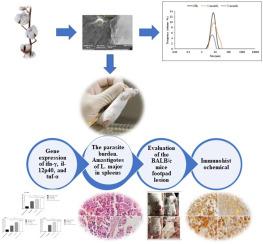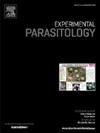Preparation, characterization, and in vivo activity of Gossypium hirsutum niosomes against cutaneous leishmaniasis caused by Leishmania major in a murine model: Parasite burden, gene expression, and histopathological profiling
IF 1.6
4区 医学
Q3 PARASITOLOGY
引用次数: 0
Abstract
The use of conventional drugs is not a satisfactory treatment for the disease. Therefore, there is a crucial need for alternative therapeutic approaches. This study aimed to investigate the potential anti-leishmanial activity of Gossypium hirsutum niosomes against cutaneous leishmaniasis in a murine model and evaluate their effectiveness by assessing parasite burden, immunomodulatory gene expression, and histopathological profile. We prepared G. hirsutum niosomes and characterized their morphology, size, Fourier transform infrared spectroscopy (FT-IR), and encapsulation efficiency. The in vivo anti-leishmanial activity of the niosomes was evaluated by assessing parasite burden, histopathological profile, and gene expression level. The spleen parasite load in BALB/c mice treated with different groups of G. hirsutum niosomes and G. hirsutum extracts (30%), demonstrated a significant decrease compared to Glucantime®. The least number of leishmanial parasites was observed in H and E-stained histological sections (grade+1), followed by G. hirsutum niosomes or G. hirsutum crude extract (grade+3), Glucantime® (grade+4) and the highest number in the untreated control group (grade+6). There was a substantial difference (P < 0.001) among various treatment groups. Moreover, G. hirsutum niosomes up-regulated the levels of the gene (particularly IFN-γ, P < 0.001) compared to the extract form and Glucantime®. In contrast, IL-4, IL-10, and TNF-β were significantly decreased (P < 0.001) in comparison to untreated control. These results suggest that G. hirsutum niosomes have the potential to be considered a promising alternative therapy for leishmaniasis. Further research is warranted to explore their mechanism of action and optimize their formulation for clinical use.

在小鼠模型中制备、表征和体内活性的大叶格桑籽果糖体,用于防治由大叶利什曼病引起的皮肤利什曼病:寄生虫负担、基因表达和组织病理学分析
使用传统药物治疗这种疾病的效果并不理想。因此,迫切需要替代治疗方法。本研究旨在通过评估寄生虫负担、免疫调节基因表达和组织病理学特征,研究在小鼠模型中使用长柄格桑子(Gossypium hirsutum niosomes)对皮肤利什曼病的潜在抗利什曼病活性,并评估其有效性。我们制备了长春花苷胶囊,并对其形态、大小、傅立叶变换红外光谱(FT-IR)和封装效率进行了表征。通过评估寄生虫载量、组织病理学特征和基因表达水平,评价了大花蓟黄酮胶囊的体内抗利什曼病活性。与 Glucantime® 相比,用不同组的 G. hirsutum niosomes 和 G. hirsutum 提取物(30%)处理 BALB/c 小鼠的脾脏寄生虫量显著减少。在 H 和 E 染色的组织学切片中观察到的利什曼寄生虫数量最少(+1 级),其次是 G. hirsutum niosomes 或 G. hirsutum 粗提取物(+3 级)、Glucantime®(+4 级),而未经处理的对照组数量最多(+6 级)。各处理组之间存在显著差异(P < 0.001)。此外,与提取物和 Glucantime® 相比,G. hirsutum niosomes 能上调基因水平(尤其是 IFN-γ,P < 0.001)。相反,与未处理的对照组相比,IL-4、IL-10 和 TNF-β 的水平明显下降(P < 0.001)。这些结果表明,G. hirsutum niosomes 有可能被视为治疗利什曼病的一种有前途的替代疗法。有必要进一步研究其作用机制,并优化其临床应用配方。
本文章由计算机程序翻译,如有差异,请以英文原文为准。
求助全文
约1分钟内获得全文
求助全文
来源期刊

Experimental parasitology
医学-寄生虫学
CiteScore
3.10
自引率
4.80%
发文量
160
审稿时长
3 months
期刊介绍:
Experimental Parasitology emphasizes modern approaches to parasitology, including molecular biology and immunology. The journal features original research papers on the physiological, metabolic, immunologic, biochemical, nutritional, and chemotherapeutic aspects of parasites and host-parasite relationships.
 求助内容:
求助内容: 应助结果提醒方式:
应助结果提醒方式:


